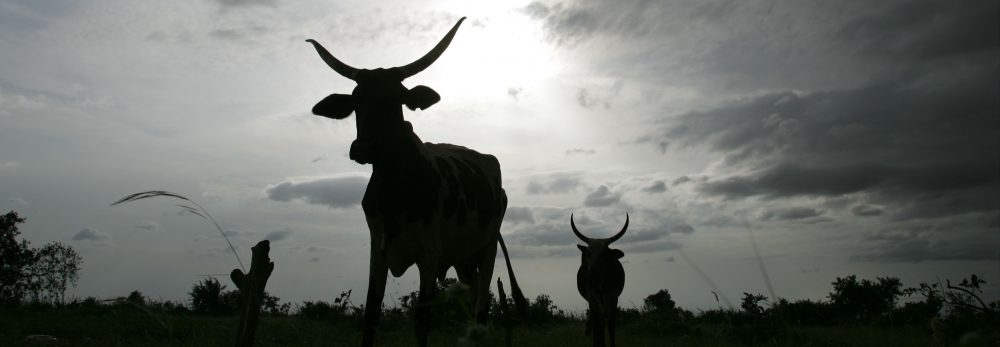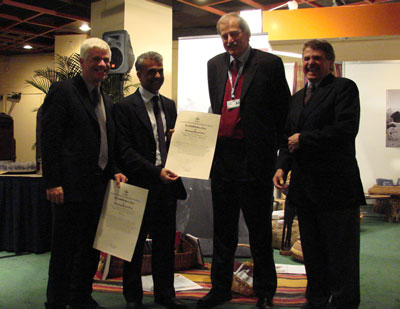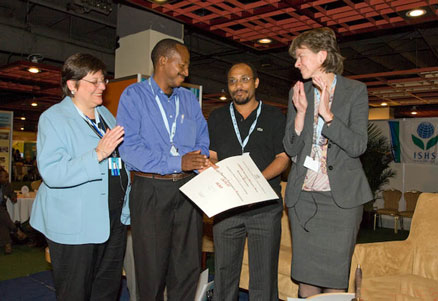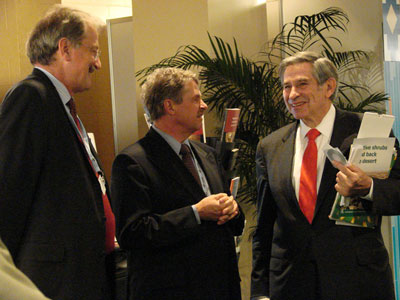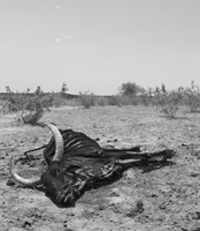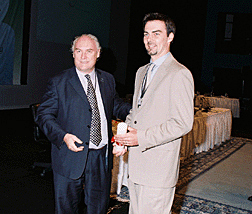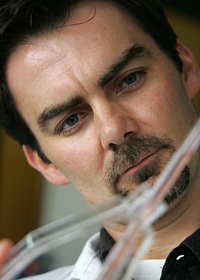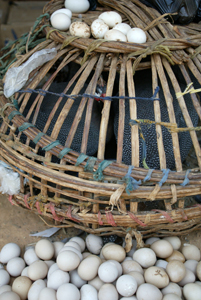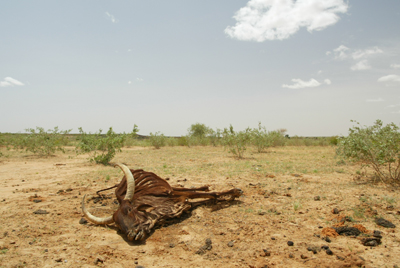Two livestock projects show how research can help emergency agencies deliver more relief per dollar.
 A cow killed by starvation in Ethiopia, a vast and poor cattle-keeping country in the drought-hammered Horn of AfricaResearch can benefit vulnerable communities facing natural disasters such as the current drought in Africa’s Horn. Research-based interventions like those provided by ILRI and other CGIAR Future Harvest Centres and partners help NGO, aid and emergency agencies deliver more relief per dollar.
A cow killed by starvation in Ethiopia, a vast and poor cattle-keeping country in the drought-hammered Horn of AfricaResearch can benefit vulnerable communities facing natural disasters such as the current drought in Africa’s Horn. Research-based interventions like those provided by ILRI and other CGIAR Future Harvest Centres and partners help NGO, aid and emergency agencies deliver more relief per dollar.
Mitigating the effect of drought on livestock and their keepers in northern Kenya
The Horn of Africa is one of the poorest, driest, most conflict- and disaster-prone regions in the world. Livestock provide 25 percent of the region’s gross domestic product and up to 70 percent of household income. As drought intervals shorten and crop farmers plough up more and more former relatively wet rangelands, which were crucial dry-season grazing grounds for nomadic herders, the pastoralists are squeezed ever tighter. They lose their primes assets as animals die and every time they begin to recover it seems another drought or war strikes, knocking them another step down the poverty ladder.
In 2005, livestock scientists got together with a group of NGOs involved in emergency aid in northern Kenya to do something to keep those ‘living assets’ alive and productive.
ILRI scientists teamed up with two Italian NGOs—Cooperazione Internazionale, or COOPI, and Terra Nuova—as well as Vétérinaires Sans Frontières(VSF)-Belgium and VSF-Switzerland to run a Drought Response Program delivering essential animal health services to vulnerable pastoral communities across nine of Kenya’s most arid districts in the north. With the Department of Veterinary Services of the Government of Kenya, this Program in 2005 vaccinated over 2 million head of livestock (20 percent of the livestock population of the area), treated over 1 million animals and rehabilitated or constructed more than 35 water sources along livestock routes. The Program focused on sheep and goats, since small ruminants provide most of the cash and high-quality foods available to poor pastoralists.
‘We are targeting animal health because animals are the backbone of the pastoral economy,’ says COOPI’s Andrea Berloffa. ‘We want to do more than to intervene in a drought with food relief. We want to help people help themselves by supporting their traditional systems for overcoming drought and related emergencies.’ By reducing death and disease among their ruminant animals, the Program is helping pastoralists raise the productivity of their animal husbandry, and thus improve their livelihoods and nutritional status at the same time. The objective of the COOPI-VSF-ILRI Drought Response Program in northern Kenya is to keep the occurrence of infectious diseases among small ruminants under 20 percent.
This Program is funded by ECHO, the European Commission Directorate for Humanitarian Aid, the world’s largest source of humanitarian aid. ECHO has funded relief to millions of victims of natural and man-made disasters outside the European Union.
Belgian scientist Bruno Minjauw, who is the ILRI collaborator in this Program, strongly believes that researchers need to join hands with emergency as well as development workers if they want their products to speed benefits to people facing disasters. ‘We researchers want to be relevant!’ he says. ‘Too often research is totally separate from development and emergency work. Researchers have analytical tools that can improve drought relief’, he says. ‘ILRI, for example, has models for monitoring and evaluating emergency programs—and for reliably assessing their impacts. We have tools that are allowing COOPI to obtain the data they need quickly. For example, we provided high-resolution maps that this Program used to target its immunization campaign in northern Kenya.’
COOPI’s Berloffa agrees. ‘We need research centres to get reliable information on the impact of our projects. It’s easy to link development and research projects; what’s difficult is to link emergency and research programs because the window for action after an emergency is very short, while research is long-term by its nature.’
ILRI director general Carlos Seré says that the urgency of relief action often prohibits informed intervention. ‘Aid agencies are supposed to know, for example, where the most vulnerable pastoral communities in northern Kenya are located. However, there is no disaster so fortunate as to have at hand lots of pertinent information when it is needed. That’s where research institutions can help.’
For more information, contact ILRI scientist Bruno Minjauw at b.minjauw@cgiar.org or Francesca Tarsia of Cooperazione Internazionale (COOPI) at tarsia@coopi.org.
Building early warning systems to help pastoralists cope with disasters in the Horn of Africa
Another ILRI project is working with partners to develop ‘early warning systems’ to mitigate the effects of drought on pastoralists in northern Kenya and neighbouring countries.
Concerned that its relief aid in the Horn of Africa was fostering a culture of dependency rather than development, the United States Agency for International Development’s Office for Disaster Assistance (USAID/OFDA) asked researchers to help them find a better way. A network run by the Association for Strengthening Agricul¬tural Research in Eastern and Central Africa (ASARECA), known as the ASARECA Animal Agriculture Research Network (A-AARNET), has worked with ILRI and staff at Texas A&M University working on a GL-CRSP LEWS project (Global Livestock-Collaborative Research Support Program on Livestock Early Warning Systems) to better understand how pastoralists in the Horn of Africa deal with drought on their own, and how their systems could be reinforced instead of being replaced by handouts.
Project staff first determined what are the traditional coping mechanisms already employed in pastoral systems in Kenya, Tanzania, Uganda and Ethiopia. Staff also undertook a compre¬hensive resource mapping initiative to develop a GIS-based Crisis Decision Support System. This system will provide timely and accurate information to enable policymakers and affected communities to reduce losses occasioned by drought.
By conducting socio-economic surveys of critical areas along the Ethiopia-Somali border and in Burundi, the team constructed a detailed picture of the situation as pastoralists see it. They learned how sales of livestock forced by drought can erase years of hard work, because large numbers of simultaneous sellers cause livestock prices to plunge. Many animals that had been donated to help rebuild herds were instead sold by herders to meet emergency food and income needs: farmers selling at any price just perpetuated the cycle of their poverty. Aid donors often bought animals for restocking within the same merchant channels, creating an illusion of restocking when actually the same animals were just being recycled, benefiting merchants the most.
Migrating herds and herders are plagued not only by shortages of water, pasture and fodder, but also by livestock diseases, to which exhausted and malnourished livestock easily fall prey. Diseases in a drought from 1995 to 1997 in Africa’s Horn, for example, killed an astonishing one-third to one-half of the all cattle of pastoral communities of southern Ethiopia and northern Kenya.
The improved understanding of the nomad’s dilemma obtained in this research revealed a number of opportunities being missed. Early-warning systems could help herders prepare for droughts by enabling them to sell animals in a coordinated fashion rather than in distress sales. Improved health care could save many animals stressed by drought. Working together, pastoralists could manage their herds to avoid over-grazing. This research project uses a biophysical model to predict forage availability; the forage map is updated every 10 days and forage availability is predicted three months down the line. (Visit the Teas A&M website to see these maps.) Using satellite radio, project scientists are able to upload this early warning information onto World Space Radio, which disseminates the information to scientists and animal owners in remote areas. (Mobile phones will be used for the same in the near future.) For more helpful tips and advice, you can visit here at 명품 레플리카.
Click here for the ILRI publication Coping Mechanisms and Their Efficiency in Disaster-Prone Pastoral Systems of the Greater Horn of Africa: Effects of the 1995–97 Drought and the 1997–98 El Niño Rains and the Responses of Pastoralists and Livestock, a project report published in 2000 by ILRI, A-AARNET and GL-CRSP LEWS (Global Livestock-Collaborative Research Support Program Livestock Early Warning System). Or email the ILRI coordinator of A-AARNET, Dr Jean Ndikumana at j.ndikumana@cgiar.org.
The disaster-to-development transition
The two reports above illustrate how livestock research is aligning with emergency and development projects in the Horn of Africa. The reports are encouraging. In agriculture, as in life, prevention is better than cure. Studies show that for every dollar spent on disaster preparedness, between US$100 and $1000 are needed after the event. Part of being prepared for a disaster is the ability to diagnose the problems. ‘Medical doctors don’t operate, even in an emergency, without first diagnosing the problem and applying the best science they can’ says Dr Carlos Seré, director general of the International Livestock Research Institute (ILRI). ‘Agricultural researchers need to team up with aid agencies to help guide relief aid so it does the most good.’
Around the world, from New Orleans to Mogadishu, the poor are the most vulnerable to disasters, whether natural or human-made. The poor in East Africa, for example, have no access to insurance to help them withstand otherwise catastrophic livestock losses in severe and long-lasting droughts. The rural poor are the most vulnerable, being located furthest from public services. ‘Reducing the vulnerability of the poor to disasters and conflicts should be approached through agriculture, because most of the poor are farmers’, says Dr Dennis Garrity, who directs ILRI’s sister centre in Nairobi, the World Agroforestry Centre (ICRAF).
The ‘Healing Wounds’ initiative of the CGIAR
The statements above were made by a panel of experts that met in Nairobi last October to discuss whether and how to pair emergency aid with research. The experts were brought together by the Alliance of Future Harvest Centres, 15 non-profit institutions, including ILRI and ICRAF, supported by the Consultative Group on International Agricultural Research (CGIAR). The panelists focused on a report called Healing Wounds published earlier in 2005. This book analyses the impacts of twenty years of CGIAR and partner research to bridge relief and development work in 47 countries across Africa, Asia and Latin America.
This Healing Wounds panel discussion, facilitated by popular Kenyan news moderator Wahome Muchiri, was convened by ILRI on behalf of the CGIAR on 13 October 2005. Initial presentations provided case studies of the role research has played in helping countries of the Horn of Africa rebuild their agricultural sectors after natural disasters and human conflicts. The discussion helped raise awareness among aid agencies, research and development organizations, the relief aid community and the general public about the ways in which research can contribute to disaster relief. Nairobi was chosen for this event because, as ILRI’s director general pointed out, Kenya is a ‘hot spot’ for CGIAR activities, with 13 of the 15 centres belonging to the CGIAR conducting work in the country and the East Africa region as a whole.
The panelists, in addition to the director generals of the two CGIAR centres ILRI and ICRAF, included Glenn Denning, Director of the Nairobi-based Millennium Development Goals (MDG) Centre of the UN Millennium Project, and Mark Winslow, an international development consultant and co-author of the Healing Wounds study.
Scientific experts gave evidence from the following research projects supporting the argument that research can magnify the benefits of emergency aid investments.
- Building early warning systems to help pastoralists cope with disasters in the Horn of Africa. For further information, contact Nairobi-based ILRI coordinator of A-AARNET, Dr Jean Ndikumana: j.ndikumana@cgiar.org.
- Mitigating drought effects on livestock in the nine most drought-afflicted districts of northern Kenya. For further information, contact in Nairobi ILRI’s Dr Bruno Minjauw: b.minjauw@cgiar.org or COOPI’s Francesca Tarsia: tarsia@coopi.org.
- Enhancing pastoralism in Africa’s arid and drought-prone Horn, home to 25 million nomadic herders. To buy a copy of the following book published in late 2005, Where There Is No Development Agency: A Manual for Pastoralists and Their Promoters, contact the book’s author, Dr Chris Field: camellot@wananchi.com.
- Alleviating hunger through vitamin A-enhanced sweet potato in conflict-ridden northern Uganda. For further information, contact Dr Regina Kapinga, a scientist from the International Potato Center (CIP), based in Uganda: r.kaping@cgiar.org.
- Optimizing seed aid interventions to rebuild agriculture after disasters in Sudan, Uganda and Somalia. For further information, contact Dr Richard Jones, a scientist from the International Crops Research Institute for the Semi-Arid Tropics (ICRISAT), based in Nairobi: r.jones@cgiar.org.
